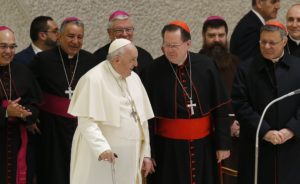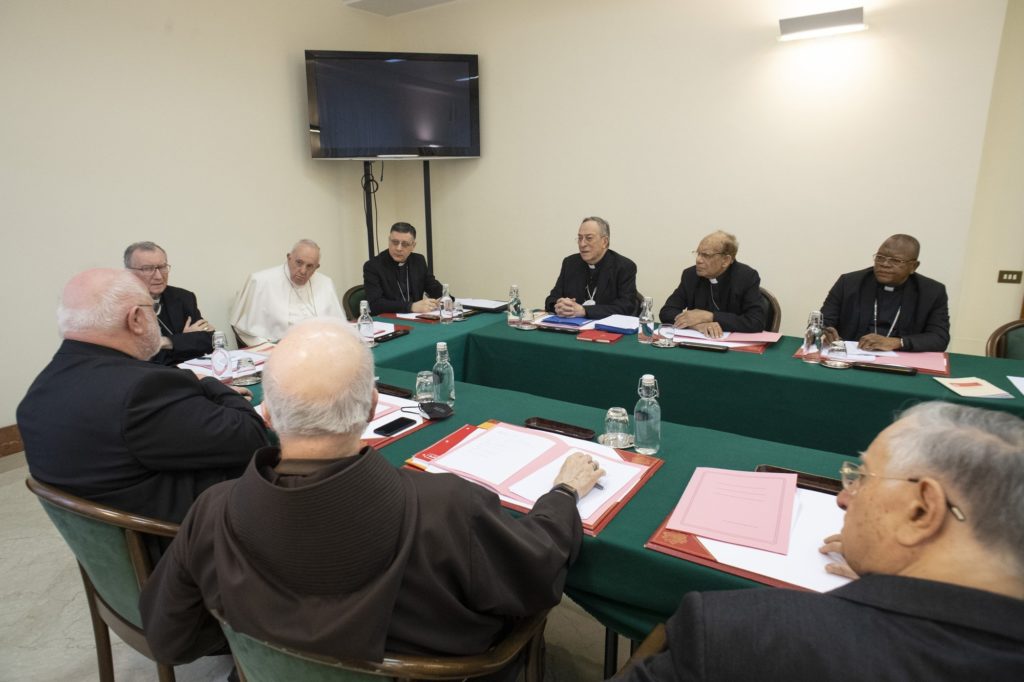ROME — When Pope Francis a decade ago announced the creation of a council of cardinals to advise him on Vatican reform and other matters of Church governance, it seemed a whole program of governance in miniature.
First of all, these were residential cardinals, not Vatican potentates, which appeared to signal that under Francis, the voices of the local churches would count for at least as much as that of the Roman Curia.
Cardinal Jorge Mario Bergoglio of Buenos Aires, Argentina, after all, had himself been the leader of a local church for a decade and a half, sometimes chafing against what he considered Roman micromanagement and incomprehension. Indeed, the decree establishing the council said the idea had been floated during general congregation meetings of cardinals during the run-up to the conclave, suggesting this was the new pope’s determination to act on the advice he had received.
Second, this was clearly and deliberately a global group. The original lineup included:
- Óscar Andrés Rodríguez Maradiaga, Honduras (coordinator)
- Laurent Monswengo Pasinya of Kinshasa, the Democratic Republic of Congo
- Oswald Gracias of Mumbai, India
- Reinhard Marx of Munich, Germany
- Francisco Javier Errazuriz Ossa of Santiago, Chile
- Sean O’Malley of Boston, United States
- George Pell of Sydney, Australia
- Giuseppe Bertello, president of the Vatican City State
In 2014, Italian Cardinal Pietro Parolin, the pope’s new secretary of state, was added to the group.
Of those original nine nominees, two were from Latin America and one each from Africa, Asia and Oceania, with the remaining three from Europe and one from North America. In other words, more than half the membership came from outside the West, paralleling the broader Catholic population in the 21st century.
Third, the choice to create such a “kitchen cabinet” also suggested this was to be a collegial papacy, though the preferred term later would become “synodal.” In any event, the idea was that under Francis, decisions would reflect broad consultation and a sense of shared participation, rather than simply papal or Vatican fiat.
Now 10 years on, it’s a matter of debate how much of that original promise has been realized.

In terms of deference to local churches, there did seem movement in that direction in 2017 when Francis returned authority over liturgical translation that had been centralized in Rome under Pope John Paul II to local bishops and bishops’ conferences.
More recently, however, critics argue the trend lines have been running in the opposite direction. Over the last 12 months, Francis has centralized control over the foundation of new religious orders, financial administration over previously autonomous entities, and permission for celebration of the old Latin Mass, in each case taking away authority that once belonged to local churches.
As for globality, Francis has realigned the traditionally western ethos of the Vatican in multiple ways. The Holy See’s diplomatic line on Ukraine, for instance, arguably has more in common with Beijing and New Delhi than with Washington and Brussels.
Yet in other respects, critics argue that the pontiff’s globality extends only so far. Some observers believe his progressive theological agenda, for instance, owes more to avant-garde intellectual circles in western Europe, especially German-speaking regions, than it does to the more traditional orientation of, say, the Church in Africa, or much of Asia, or the Middle East and Eastern Europe.
Similar observations could be made about the synodal thrust of the Francis papacy, which is projected to come to a crescendo with the pontiff’s two summits of bishops in Rome this fall and in October 2024. Here, too, critics would argue that the early promise of synodality, including the role of the Council of Cardinals, over time gave way to the reality of a pontiff increasingly inclined to rule by decree.
Many observers actually believed that Francis might be content simply to allow the Council of Cardinals to fade into oblivion. In that sense, a recent reboot of the council takes on outsized importance as a harbinger of the direction of the pontiff’s broader reform.
On March 7, the Vatican announced that the council was being renewed. O’Malley would remain, along with Parolin and Gracias, as well as Cardinal Fridolin Ambongo Besungu, Monsweongo’s successor, who was named to the body in October 2020.
New members include:
- Cardinal Jean-Claude Hollerich of Luxembourg, president of the Commission of the Bishops’ Conferences of the European Union.
- Cardinal Fernando Vérgez Alzaga, president of the Governorate of the Vatican City State.
- Cardinal Juan José Omella Omella of Barcelona, Spain, president of the Spanish Bishops’ Conference.
- Cardinal Gérald Lacroix of Quebec, Canada.
- Cardinal Sérgio da Rocha of São Salvador da Bahia, Brazil, former president of the Brazilian Bishops’ Conference.
By effectively creating the “Council of Cardinals 2.0,” Francis has signaled he wants the body to return to a protagonist’s role, obviously outliving its original mandate of advising Francis on the reform of the Roman Curia, which is now a fait accompli with the 2022 apostolic constitution “Praedicate evangelium” (“Preach the gospel”).
The extent to which the new council models the concept of synodality that Francis aspires to — not merely echoing the pope’s proposals, in other words, but also pursuing its own agenda, reflecting the outlooks and desires of the local churches it’s intended to represent — will go a long way toward determining whether this second act of the “C-9” leaves behind a different legacy than the first.

